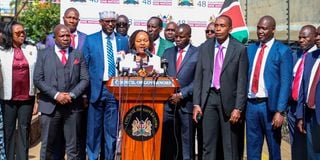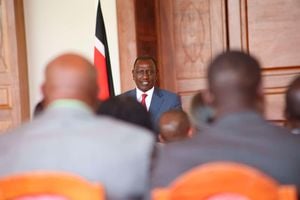Should counties be merged to save costs?

Council of Governors chairperson Anne Waiguru (centre) with her colleagues during a past media briefing in Nairobi.
What you need to know:
- The number of constitutional and statutory bodies have skyrocketed since 2010.
- There is an underlying constitutional rationale for the existence of many entities.
In the Bible, 1st Samuel 8: 4 to 20, God and the people of Israel debate the advantages and disadvantages of having a King.
The story starts with a note that Samuel's "sons are as corrupt as Eli" and are not worthy to inherit aging Samuel's leadership.
The people therefore demand a King like "other nations". They are demanding a political paradigm shift away from charismatic leadership system to more a organised structure of government. God tells Samuel to obey the people but warned of, amongst other things, an expanded flamboyant government that will levy more taxes.
And it seems that is exactly what Kenyans did for themselves with 2010 Constitution.
Cabinet Secretary John Mbadi, during his parliamentary vetting, excited the public when he decried the high resources that run our new model of governance. Social media is awash with comparisons between Kenya and other advanced societies in terms of governance structure.
US has 50 states with a population of 300 million plus and 40 times richer than Kenya. Kenya has 45 million persons but 47 counties. Notwithstanding this, Kurias in Migori and Tesos in Busia would prefer distinct counties.
National People's Congress of China has 2,977 members who represent a population of 1.4 billion persons. India has 550 MPs with a similar population of 1.4 billion persons.
Kenyan MPs are 349.
The constitution also created 14 constitutional commissions and two independent offices to deal with overlapping and crosscutting issues of human rights and public service recruitments.
Smaller and leaner government
Money directed to poverty reduction measures. Better schools. Better healthcare. Higher water connectivity.
Most pieces of legislations often contain establishment of a board. Bearers of these offices demand extra perks and benefits which Kenyans shoulder through taxes. Plus trainings and benchmarking.
These are irrefutable facts. The number of constitutional and statutory bodies have skyrocketed since 2010.
It appears Kenyan constitutional designers together with our legislative philosophy holds the view that every Kenyan problem is to be solved through establishment of some public office. Poverty somewhere? Create an office. Youth unemployment? Establish some office.
One imagines the efficiency and cost savings Kenya would accrue if the government was smaller and leaner.
Money directed to poverty reduction measures. Better schools. Better healthcare. Higher water connectivity.
So,what is the solution? Well, on the face of it, it would appear abolition of those offices and merger of counties would be the obvious solutions.
Wait a minute - there are two important possible problems.
First is the "adoption problems". We can all wish for the ideal but must confront practical challenges. How do we expect the holders of these offices to just go home? Some holders would probably rush to court and obtain some injuctions arguing "unconstitutional constitutional amendments".
Some of the necessary steps needed to realise this office reduction require concurrence of some of these office holders. Constitutional amendments require parliamentary approval. Of course there exists legal ways to circumvent such approvals.
Kenya's untidy politics
But that requires high social consensus. Probably a social and political revolution . What jurists refer as constitutional moments - instances when institutions undergo rapid changes. Often civil wars and heavy political upheavals.
Prof Samuel Huntington in his book 'The Promise of Disharmony', describes the situation to mean "when the gulf between our lofty ideals and our crummy practices becomes too wide, politics engages not in just our vulgar interests but our creedal passions."
The second problem would be Kenya's untidy politics that some of these expensive constitutional designs were meant to cure. Take for instance the many counties.
It might appear wise to collapse them into fewer entities to save costs. But, there is an underlying constitutional rationale for the existence of many entities. It is never wise to align administrative units with ethnic boundaries in an ethnically divided society. If one does the opposite, chances of fermenting ethnic nationalism supercharged by the administrative borders rise.
That is exactly what happened in Nigeria first Republic of 1963 and 1966. The country was divided into three states of Hausa/ Fulani in the North, Yoruba in Western region and Igbo in Eastern. The politics fermented by these few states led to Biafra war when Eastern region attempted to secede. Millions died and Igbo uprising was crushed.
South Sudan had to divide its states further after its civil war . The original fewer bigger states formented regionalism.
Counties should not coincide with ethnic boundaries. That can be problematic.
How to solve these twin problems of adoption and politics of ethnicity for those seeking a smaller government requires complex solutions.
Probably that demands another piece.
Irungu Kangata is the Governor for Murang'a County. Email [email protected].





